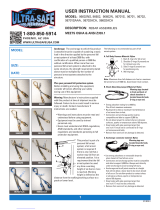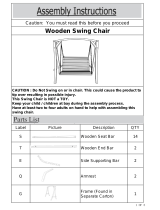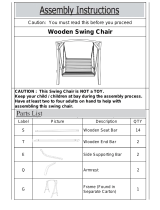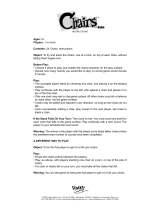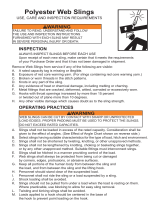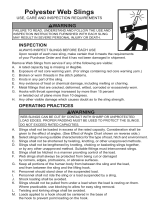Page is loading ...

© Copyright 2012, DB Industries, Inc.
DESCRIPTIONS
DBI/SALA boatswain’s chairs, work
seats, and seat slings are available
in various styles and confi gurations.
Following are descriptions of typical
systems. See Figure 1.
Boatswain’s Chair:
1001140: Seat board: 12 in. x 24 in. x 1 in.
1001134: Seat board: 12 in. x 24 in. x 1 in., tongue buckle
belt with 3 in. pad, and back D-ring
1001170: Seat board: 12 in. x 24 in. x 1 in., cushion
1001180: Seat board: 12 in. x 24 in. x 1 in., side snaps for
tools
1001190: Seat board: 12 in. x 24 in. x 1 in., cushion, side
snaps for tools
1001378: Seat board: 18 in. x 15 in. x 1 in., full chair, 420
lbs capacity
Work Seats:
1001150: Seat board: 8 in. x 18 in. x 3/4 in.
1001004: Seat board: 8 in. x 18 in. x 3/4 in.; tongue
buckle body belt; back D-ring; adjustable leg and shoulder
straps
1001044: Seat sling: 3 in. wide web; belt with suspension
D-rings
Seat Slings:
1001120: Seat sling: 4 in. wide; belt attachment loops and
suspension D-rings
1001090: Seat sling: 8 in. wide; belt attachment loops and
suspension D-rings
WARNING: This product is part of a suspended support
system. The user must follow the manufacturer’s instructions
for each component of the system. These instructions must
be provided to the user of this equipment. The user must
read and understand these instructions before using this
equipment. Manufacturer’s instructions must be followed for
proper use and maintenance of this equipment. Alterations
or misuse of this equipment, or failure to follow instructions,
may result in serious injury or death.
IMPORTANT: If you have questions on the use, care, or suitability of this equipment for your application, contact DBI/SALA.
IMPORTANT: Record the product identifi cation information from the ID label in the “Inspection and
Maintenance Log”.
USER INSTRUCTION MANUAL FOR
BOATSWAIN’S CHAIRS, WORK SEATS, AND SEAT SLINGS
This manual is intended to meet the Manufacturer’s Instructions as required by ANSI Z359.1 and
should be used as part of an employee training program as required by OSHA.
Boatswain’s Chair
(Large Seat Board)
Work Seat
(Small Seat Board)
Figure 1 - Personnel Riding Systems
Work Seat with
Seat Sling
Seat Sling
Instructions for the following series
products:
Boatswain’s Chairs, Work Seats, and Seat Slings
(See back page for specifi c model numbers.)
1001134
shown
1001004
shown
1001044
shown
1001090
shown
Form: 5902116
Rev: F

2
DEFINITIONS
ANCHORAGE: A properly selected means, such as a structural beam or member, to which the system is
anchored.
ANCHORAGE CONNECTOR: A component, such as a connector or subsystem, specifi cally intended for coupling
the system to an anchorage.
CONNECTOR: A component or element used to couple parts of the system together, such as a lifeline to an
anchorage using a carabiner as an anchorage connector.
COMPONENT: An assembly of parts which cannot be disassembled without mutilating, or without the use of
special tools, intended to perform one function in the system. Examples of components include a full body
harness, lanyard, and connector.
Work Seat
D-ring
Body Belt
ID Label
Suspension Belt
ID Label
Tool Snap
(if present)
18 X 24 X 1
Seat Board
Boatswain’s Chair
Webbing
Cushion
(if present)
Buckle
(if present)
Body Belt
(if present)
Inspection
Log Label
Suspension Belt ID Label
Inspection Log Label
Buckle
8 X 18 X 3/4 Seat Board
(if present)
Leg Straps
(if present)
Body Belt
D-ring
Shoulder Strap
(if present)
D-ring
Inspection Log Label
Suspension Belt ID Label
Seat Webbing
Seat Sling
Figure 2 - Boatswain’s Chair, Work Seat, and Seat Sling

3
WARNING: This product is part of a personal restraint, work positioning, suspension, or rescue system. These
instructions must be provided to the user and rescuer (see section 8.0 Terminology). The user must read and
understand these instructions or have them explained to them before using this equipment. The user must read
and follow the manufacturer’s instructions for each component or part of the complete system. Manufacturer’s
instructions must be followed for proper use and maintenance of this product. Alterations or misuse of this
product or failure to follow instructions may result in serious injury or death.
IMPORTANT: If you have questions on the use, care, or suitability for use of this safety equipment, contact
DBI-SALA.
1.0 APPLICATIONS
1.1 PURPOSE: Boatswain’s chairs, work seats, and seat
slings are intended to be used as part of a personnel
riding system. Applications include: Inspection work,
window washing, painting, and maintenance. Some
work seats can be used in work positioning applications.
A. PERSONNEL RIDING: Boatswain’s chairs, work
seats, and seat slings are used in conjunction with
a complete backup fall arrest system to support,
suspend, position, or transport the worker. See
Figure 3.
B. FALL ARREST (BACKUP): A separate fall
arrest system is required by OSHA to be used
with boatswain’s chairs, work seats, or slings.
This typically consists of a full body harness in
conjunction with a rope grab and lifeline.
C. WORK POSITIONING: Some work seats and tree
trimmer’s belts can be used to help position and
support the user at a work position.
1.2 LIMITATIONS: Consider the following application limitations before using this equipment:
A. CAPACITY: This equipment is designed for use by persons with a combined weight (person, clothing,
tools, etc.) of no more than 310 lbs (no more than 420 lbs for 1001378).
B. ENVIRONMENTAL HAZARDS: Use of this equipment in areas where environmental hazards exist may
require additional precautions to reduce the possibility of injury to the user or damage to the equipment.
Hazards may include, but are not limited to; high heat, caustic chemicals, corrosive environments, high
voltage power lines, explosive or toxic gases, moving machinery, or sharp edges.
C. SWING IMPACTS: Swing impacts may occur when a suspended worker uses some means to move
their seat or sling from directly beneath their anchor point. The force of striking an object in a swing
may cause serious injury or death. Minimize swing impacts by working as close to directly below the
anchorage point as possible. Do not permit a swing if injury could occur. Swinging will significantly
increase the clearance required when a self retracting lifeline or other variable length connecting
subsystem is used for the backup fall arrest system.
D. FREE FALL: Boatswain’s chairs, work seats, and seat slings are not to be used to arrest a free fall.
E. TRAINING: This equipment is intended to be used by persons trained in its correct application and use.
1.3 APPLICABLE STANDARDS: A separate fall arrest system is required by OSHA (see OSHA1910.28 and
OSHA1926.451) to be used with boatswain’s chairs work seats, or seat slings. This typically consists of a
full body harness in conjunction with a rope grab and lifeline or self retracting life line attached to the back
D-ring. Refer to national standards, including ANSI Z359.1, ANSI A10.14, and local, state, and federal
(OSHA 1910.66, appendix D, 1926.500, 1926.451) requirements for more information on personal fall arrest
systems and associated components.
WORKING
LINE
PROTECT LINES
OVER SHARP
EDGES
ANCHOR FOR
BACK-UP
FALL PROTECTION
ANCHOR FOR
WORKING
LINE
BACK UP
LIFELINE
ROPE
GRAB
SHOCK
ABSORBING
LANYARD
HARNESS
BOATSWAIN’S
CHAIR
LINES TO
LOWER LEVEL
OR GROUND
Figure 3 - Applications

4
2.0 SYSTEM REQUIREMENTS
2.1 COMPATIBILITY OF CONNECTORS: DBI/SALA equipment is designed for use with DBI/SALA approved
components and subsystems only. Substitutions or replacements made with non-approved components
or subsystems may jeopardize compatibility of equipment and may effect the safety and reliability of the
complete system.
COMPATIBILITY: Connectors are considered to be compatible with connecting elements when they
have been designed to work together in such a way that their sizes and shapes do not cause their gate
mechanisms to inadvertantly open regardless of how they become oriented. Contact DBI/SALA if you
have any questions about compatibility. Connectors ( hooks, carabiners, and D-rings) must be capable of
supporting at least 5,000 lbs. (22kN). Connectors must be compatible with the anchorage or other system
components. Do not use equipment that is not compatible. Non-compatible connectors may unintentionally
disengage. See Figure 4. Connectors must be compatible in size, shape, and strength. Self locking snap
hooks and carabiners are required by ANSI Z359.1 and OSHA.
2.2 MAKING CONNECTIONS: Only use self-locking snap hooks and carabiners with this equipment. Only use
connectors that are suitable to each application. Ensure all connections are compatible in size, shape and
strength. Do not use equipment that is not compatible. Ensure all connectors are fully closed and locked.
DBI/SALA connectors (snap hooks and carabiners) are designed to be used only as specifi ed in each
product’s user’s instructions. See Figure 5 for inappropriate connections. DBI/SALA snap hooks and
carabiners should not be connected:
A. To a D-ring to which another connector is attached.
B. In a manner that would result in a load on the gate.
NOTE: Large throat opening snap hooks should not be connected to standard size D-rings or similar objects which will
result in a load on the gate if the hook or D-ring twists or rotates. Large throat snap hooks are designed for use on
fi xed structural elements such as rebar or cross members that are not shaped in a way that can capture the gate of the
hook.
C. In a false engagement, where features that protrude from the snap hook or carabiner catch on the anchor
and without visual confirmation seems to be fully engaged to the anchor point.
D. To each other.
E. Directly to webbing or rope lanyard or tie-back (unless the manufacturer’s instructions for both the
lanyard and connector specifically allows such a connection).
F. To any object which is shaped or dimensioned such that the snap hook or carabiner will not close and
lock, or that roll-out could occur.
G. In a manner that does not allow the connector to align properly while under load.
Figure 4 - Unintentional Disengagement Figure 5 - Inappropriate Connections
If the connecting element to which a snap hook (shown) or carabiner attaches
is undersized or irregular in shape, a situation could occur where the connecting
element applies a force to the gate of the snap hook or carabiner. This force may
cause the gate (of either a self-locking or a non-locking snap hook) to open,
allowing the snap hook or carabiner to disengage from the connecting point.
Small ring or other
non-compatibly
shaped element
Force is applied to the
Snap Hook.
The Gate presses against
the Connecting Ring.
The Gate opens allowing
the Snap Hook to slip off.
A. B. C. D.
E. F. G.
2.3 ANCHORAGE STRENGTH: The anchorage strength required is dependent upon the application:
A. PERSONNEL RIDING: The structure (mounting surface) selected for personnel riding applications must
sustain a static load of at least 2,500 lbs. applied in the directions permitted by the personnel riding
system when in use.
B. FALL ARREST (BACKUP SYSTEM): Anchorages used for personal fall arrest systems must be capable
of sustaining static loads in the directions permitted by the personal fall arrest system of at least: 3,600

5
lbs. with certification of a qualified person; or 5,000 lbs. without certification. See ANSI Z359.1 for
certification definition. When more than one personal fall arrest system is attached to an anchorage, the
strengths stated above must be met at each anchorage location independently.
FROM OSHA 1926.500 AND 1910.66: Anchorages used for attachment of personal fall arrest systems
shall be independent of any anchorage being used to support or suspend platforms, and capable
of supporting at least 5,000 lbs. per user attached, or be designed, installed, and used as part of a
complete personal fall arrest systems which maintains a safety factor of at least two, and is under the
supervision of a qualified person.
C. WORK POSITIONING: The structure to which the work positioning system is attached must sustain
static loads applied in the directions permitted by the work positioning system of at least 3,000 lbs., or
twice the potential impact load, whichever is greater. See OSHA 1926.502. When more than one work
positioning system is attached to an anchorage, the strengths stated above must be multiplied by the
number of work positioning systems attached to the anchorage.
3.0 OPERATION AND USE
WARNING: Do not alter or intentionally misuse this equipment. Consult DBI/SALA when using this equipment in combination
with components or subsystems other than those described in this manual. Some subsystem and component combinations
may interfere with the operation of this equipment. Use caution when using this equipment around moving machinery,
electrical hazards, chemical hazards, and sharp edges.
WARNING: Consult your doctor if there is reason to doubt your fi tness to safely absorb the shock from a fall arrest. Age and
fi tness seriously affect a worker’s ability to withstand falls. Pregnant women or minors must not use DBI/SALA boatswain’s
chairs, work seats, seat slings, or fall arrest back up systems.
3.1 BEFORE EACH USE of this equipment, carefully inspect it according to steps listed in section 5.0 of this
manual.
3.2 PLAN your fall arrest system before using this equipment. Consider all factors that will affect your safety
during use of this equipment. Consider the following points when planning your system:
A. ANCHORAGE: Select a rigid anchor point that is capable of sustaining the loads specified in section 2.3.
For fall arrest applications, select anchorage locations that will minimize free fall and swing fall hazards.
B. FALL CLEARANCE (BACKUP FALL ARREST): Ensure sufficient clearance exists in your fall path to
prevent striking an object during a fall. The clearance required is
dependent upon the subsystem (rope grab and lanyard, rope grab
and carabiner) and lifeline properties.
C. SHARP EDGES: Avoid working where your chair’s support system,
lifeline subsystem, or other system components will be in contact
with, or abrade against, unprotected sharp edges. If working
with this equipment around sharp edges is unavoidable, provide
protection by using a heavy pad over the exposed sharp edge.
D. RESCUE: The employer must have a rescue plan and the ability to
implement it.
E. AFTER A FALL: Components which have been subjected to fall
arrest forces must be removed from service and destroyed.
F. GENERAL USE CONSIDERATIONS: Avoid working where your
lifeline may cross or tangle with that of another worker. Do not allow
your lifeline to pass under your arms or between your feet.
3.3 DONNING AND USE: Sit in the chair or sling with the support webbing
in front of your body. If belts are present, make sure the belts pass
through the appropriate loops in the webbing to assure the user is tied
into the system correctly. Refer to Figure 1 for examples of properly
donned equipment. Make sure belts are snug and buckles are fully
engaged (see Figure 6). If leg straps are present, secure the straps
around each leg and adjust to a snug fi t. For seat slings, position the
seat webbing under the buttocks for maximum support and comfort.
Attach backup fall protection system per the manufacturer’s instructions
for that system.
3.4 AFTER USE of this equipment, clean and store according to section 6.0
of this manual.
Figure 6 - Buckle Connections
Parachute Buckle: Pass
webbing under buckle and
over roller and down between
roller and frame. Pull web end
to tighten. Three inches of web
must extend past buckle.
Tongue Buckle: Pass webbing
through buckle and insert
tongue through grommet.

6
4.0 TRAINING
4.1 It is the responsibility of the user to assure they are familiar with these instructions, and are trained in the
correct care and use of this equipment. User must also be aware of the operating characteristics, application
limits, and the consequences of improper use of this equipment.
WARNING: Training must be conducted without exposing the trainee to a fall hazard. Training should be repeated on a
periodic basis.
5.0 INSPECTION
5.1 FREQUENCY:
• Before Each Use inspect according to steps listed in section 5.2.
• This Equipment must be inspected according to steps listed in section 5.2 by a competent person, other
than the user, at least annually. Record the results of each inspection in the “Inspection and Maintenance
Log”.
IMPORTANT: Extreme working conditions (harsh environments, prolonged use, etc.) may require increasing the
frequency of inspections.
5.2 INSPECTION STEPS:
Step 1. Inspect hardware (D-rings, buckles, tool snaps, etc.). These items must not be damaged, broken or
distorted. These items must be free of sharp edges, burrs, cracks, worn parts, or corrosion. Hook
gates must move freely and lock upon closing.
Step 2. Inspect webbing for concentrated wear. Material must be free of frayed strands, broken yarns, cuts,
abrasions, burns, and discoloration. The webbing must be free of excessive soiling, paint build-up,
and rust staining. Check for chemical or heat damage; indicated by brown, discolored, or brittle
areas. Check for ultraviolet damage; indicated by discoloration and splinters and slivers along the
webbing surface. All of the above factors are known to reduce strength. Damaged or questionable
webbing should be removed from use.
Step 3. Inspect the wooden seat of the chair for cracks, especially near the webbing holes. Also check for
rough edges or gouges that could result in slivers.
Step 4. Inspect labels. All labels must be present and fully legible. See “Labeling”.
Step 5. Inspect each system component or subsystem according to manufacturer’s instructions.
Step 6. Record the inspection date and results in the “Inspection and Maintenance Log”.
5.3 If inspection reveals an unsafe or defective condition, remove the equipment from service and destroy, or
contact an authorized service center for repair.
6.0 MAINTENANCE, SERVICING, STORAGE
6.1 Clean the webbing with water and a mild detergent. Wipe hardware dry with a clean, dry cloth and hang to
air dry. Do not force dry with heat. An excessive build-up of dirt, paint, etc. may in severe cases, weaken
the webbing.
6.2 Additional maintenance and servicing procedures must be completed by an authorized service center.
Authorization must be in writing. Do not disassemble this equipment.
6.3 Store the chair or sling in a cool, dry, clean environment, out of direct sunlight. Avoid areas where chemical
vapors may be present. Thoroughly inspect the equipment after extended storage.

7
7.0 SPECIFICATIONS
7.1 MATERIALS SPECIFICATIONS:
BOATSWAIN’S CHAIRS:
Model no. 1001140, 1001134, 1001170, 1001180, 1001190, 1001378
D-ring: Drop forged, alloy steel 5,000 lbs. tensile strength.
Webbing: Polyester
wooden seat: 1 in., 15 ply plywood
Thread: Polyester, size 346 and nylon, size 69
WORK SEATS:
Model no. 1001150
V-ring: Drop forged, alloy steel 4,000 lbs. tensile strength.
Webbing: Polyester
wooden seat: 3/4 in., 13 ply plywood
Model no. 1001004
D-ring: Drop forged, alloy steel 5,000 lbs. tensile strength.
Webbing: Polyester
wooden seat: 3/4 in., 13 ply plywood
Thread: Polyester, size 346 and nylon, size 69
Model no. 1001044
D-ring: Drop forged, alloy steel 5,000 lbs. tensile strength.
Webbing: Polyester
Thread: Polyester, size 346 and nylon, size 69
SEAT SLINGS:
Model no. 1001120, 1001090
D-ring: Drop forged, alloy steel 5,000 lbs. tensile strength.
Webbing: Polyester
Thread: Polyester, size 346 and nylon, size 69
Thread: Polyester, size 346 and nylon, size 69
8.0 TERMINOLOGY
AUTHORIZED PERSON: A person assigned by the employer to perform duties at a location where the person
will be exposed to a fall hazard (otherwise referred to as “user” for the purpose of these instructions).
RESCUER: Person or persons other than the rescue subject acting to perform an assisted rescue by
operation of a rescue system.
CERTIFIED ANCHORAGE: An anchorage for fall arrest, positioning, restraint, or rescue systems that a
qualified person certifies to be capable of supporting the potential fall forces that could be encountered
during a fall or that meet the criteria for a certified anchorage prescribed in this standard.
QUALIFIED PERSON: A person with a recognized degree or professional certificate and with extensive
knowledge, training, and experience in the fall protection and rescue field who is capable of designing,
analyzing, evaluating and specifying fall protection and rescue systems to the extent required by this
standard.

8
9.0 LABELING
9.1 THE FOLLOWING LABELS MUST BE PRESENT AND FULLY LEGIBLE:
ALL BOATSWAIN’S CHAIRS, SLING SEATS, AND TREE TRIMMER BELTS IN THIS MANUAL ARE
REQUIRED TO HAVE THE FOLLOWING TWO LABELS:
Inspection Log Label
Suspension Belt Identifi cation Label
BOATSWAIN’S CHAIR MODEL NUMBER 1001134 IS REQUIRED TO HAVE THE FOLLOWING LABEL
IN ADDITION TO THE LABELS ABOVE.
Body Belt Identifi cation Label

INSPECTION AND MAINTENANCE LOG
SERIAL NUMBER:
MODEL NUMBER:
DATE PURCHASED: DATE OF FIRST USE:
INSPECTION DATE INSPECTION ITEMS
NOTED
CORRECTIVE ACTION MAINTENANCE
PERFORMED
Approved By:
Approved By:
Approved By:
Approved By:
Approved By:
Approved By:
Approved By:
Approved By:
Approved By:
Approved By:
Approved By:
Approved By:
Approved By:
Approved By:
Approved By:
Approved By:
Approved By:
Approved By:


This instruction applies to the following Models:
1001001
1001002
1001003
1001004
1001005
1001006
1001007
1001012
1001013
1001014
1001015
1001016
1001017
1001019
1001020
1001021
1001022
1001023
1001024
1001031
1001032
1001033
1001034
1001035
1001037
1001041
1001042
1001043
1001044
1001045
1001046
1001047
1001053
1001054
1001055
1001056
1001057
1001060
1001061
1001062
1001063
1001064
1001065
1001070
1001071
1001080
1001081
1001082
1001090
1001100
1001110
1001120
1001125
1001131
1001132
1001133
1001134
1001135
1001136
1001137
1001140
1001150
1001155
1001170
1001180
1001185
1001190
1001200
1001270
1001271
1001272
1001273
1001274
1001275
1001276
1001280
1001281
1001282
1001283
1001284
1001378
1003225
1003226
8900001
Additional Model Numbers may appear on the next printing of these instructions.

LIMITED LIFETIME WARRANTY
Warranty to End User: D B Industries, Inc., dba CAPITAL SAFETY USA (“CAPITAL SAFETY”) warrants to the
original end user (“End User”) that its products are free from defects in materials and workmanship under
normal use and service. This warranty extends for the lifetime of the product from the date the product is
purchased by the End User, in new and unused condition, from a CAPITAL SAFETY authorized distributor.
CAPITAL SAFETY’S entire liability to End User and End User’s exclusive remedy under this warranty is limited
to the repair or replacement in kind of any defective product within its lifetime (as CAPITAL SAFETY in its sole
discretion determines and deems appropriate). No oral or written information or advice given by CAPITAL
SAFETY, its distributors, directors, offi cers, agents or employees shall create any different or additional
warranties or in any way increase the scope of this warranty. CAPITAL SAFETY will not accept liability for defects
that are the result of product abuse, misuse, alteration or modifi cation, or for defects that are due to a failure to
install, maintain, or use the product in accordance with the manufacturer’s instructions.
CAPITAL SAFETY’S WARRANTY APPLIES ONLY TO THE END USER. THIS WARRANTY IS THE ONLY WARRANTY
APPLICABLE TO OUR PRODUCTS AND IS IN LIEU OF ALL OTHER WARRANTIES AND LIABILITIES, EXPRESSED
OR IMPLIED. CAPITAL SAFETY EXPRESSLY EXCLUDES AND DISCLAIMS ANY IMPLIED WARRANTIES OF
MERCHANTABILITY OR FITNESS FOR A PARTICULAR PURPOSE, AND SHALL NOT BE LIABLE FOR INCIDENTAL,
PUNITIVE OR CONSEQUENTIAL DAMAGES OF ANY NATURE, INCLUDING WITHOUT LIMITATION, LOST PROFITS,
REVENUES, OR PRODUCTIVITY, OR FOR BODILY INJURY OR DEATH OR LOSS OR DAMAGE TO PROPERTY, UNDER
ANY THEORY OF LIABILITY, INCLUDING WITHOUT LIMITATION, CONTRACT, WARRANTY, STRICT LIABILITY, TORT
(INCLUDING NEGLIGENCE) OR OTHER LEGAL OR EQUITABLE THEORY.
Certificate No. FM 39709
ISO
9001
A Capital Safety Company
CSG USA & Latin America
3833 SALA Way
Red Wing, MN 55066-5005
Toll Free: 800.328.6146
Phone: 651.388.8282
Fax: 651.388.5065
solutions@capitalsafety.com
CSG Canada
260 Export Boulevard
Mississauga, ON L5S 1Y9
Phone: 905.795.9333
Toll-Free: 800.387.7484
Fax: 888.387.7484
info.ca@capitalsafety.com
CSG Northern Europe
Unit 7 Christleton Court
Manor Park
Runcorn
Cheshire, WA7 1ST
Phone: + 44 (0)1928 571324
Fax: + 44 (0)1928 571325
csgne@capitalsafety.com
CSG EMEA
(Europe, Middle East, Africa)
Le Broc Center
Z.I. 1ère Avenue
5600 M B.P. 15 06511
Carros
Le Broc Cedex
France
Phone: + 33 4 97 10 00 10
Fax: + 33 4 93 08 79 70
information@capitalsafety.com
CSG Australia & New Zealand
95 Derby Street
Silverwater
Sydney NSW 2128
AUSTRALIA
Phone: +(61) 2 8753 7600
Toll-Free : 1 800 245 002 (AUS)
Toll-Free : 0800 212 505 (NZ)
Fax: +(61) 2 87853 7603
sales@capitalsafety.com.au
CSG Asia
Singapore:
16S, Enterprise Road
Singapore 627666
Phone: +65 - 65587758
Fax: +65 - 65587058
inquiry@capitalsafety.com
Shanghai:
Rm 1406, China Venturetech Plaza
819 Nan Jing Xi Rd,
Shanghai 200041, P R China
Phone: +86 21 62539050
Fax: +86 21 62539060
www.capitalsafety.com
/
